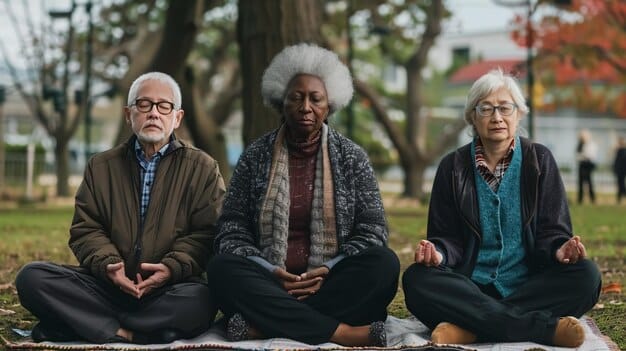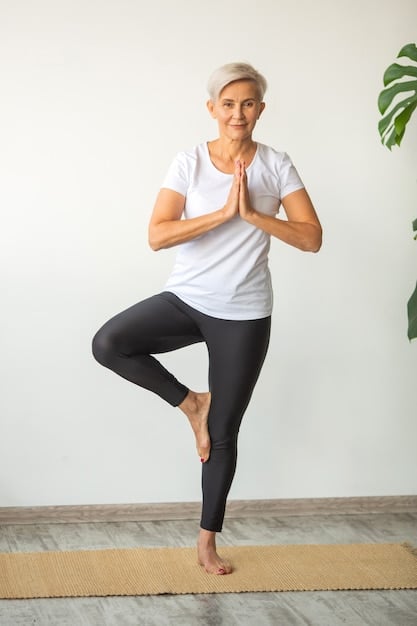Yoga for Balance: New Study Shows 40% Improvement in Over 50s

A recent study reveals that yoga can significantly enhance balance in adults over 50, showing a 40% improvement, offering a natural and effective way to reduce fall risks and improve overall stability.
Are you over 50 and looking for a way to improve your balance and stability? A new study: Yoga Improves Balance by 40% in Adults Over 50, suggesting that incorporating yoga into your routine could be a game-changer. Let’s explore the exciting findings and what they mean for you.
Yoga: A Path to Enhanced Balance
Yoga, an ancient practice blending physical postures, breathing techniques, and meditation, is gaining recognition for its multifaceted health benefits. Beyond flexibility and stress reduction, emerging research highlights yoga’s potential to significantly improve balance, particularly in older adults.
But how does yoga achieve this? By challenging our bodies in unique ways. Yoga promotes body awareness and strengthens key muscles essential for stability. Let’s explore this connection further.
The Science Behind Yoga and Balance
Studies show that specific yoga poses activate muscles responsible for maintaining balance, such as those in the core, legs, and ankles. Regular practice enhances proprioception – the body’s ability to sense its position in space – leading to improved coordination and reduced risk of falls.
Types of Yoga for Improving Balance
While many yoga styles offer balance benefits, certain forms are particularly effective. Hatha yoga, known for its slower pace and foundational poses, is an excellent starting point. Yin yoga, focusing on deep stretching and holding poses for longer durations, can improve joint stability and flexibility. Restorative yoga, using props to support the body in relaxing postures, also reduces tension which is critical in maintaining balance.

- Standing Poses: Poses like tree pose (Vrksasana) and warrior poses (Virabhadrasana I, II, III) directly challenge balance and strengthen stabilizing muscles.
- Core Engagement: Yoga emphasizes core strength, which is crucial for maintaining stability and preventing falls. Poses like boat pose (Paripurna Navasana) and plank pose (Phalakasana) strengthen the core muscles.
- Mindful Movement: Yoga encourages awareness of body alignment and weight distribution, improving proprioception and reducing the risk of imbalance.
Yoga offers a holistic approach to improving balance, addressing both physical and mental aspects. With its diverse range of styles and poses, yoga can be tailored to individual needs and abilities, making it an accessible and effective practice for enhancing stability at any age. As we continue, explore the next section with me, where we discuss the specifics of this new study.
Decoding the New Study: Key Findings
A groundbreaking study has shed new light on the incredible impact of yoga on balance in adults over 50. Let’s dissect the key findings and what they mean for enhancing stability and preventing falls.
The study’s methodology and demographics are critical to understanding the significance.
Study Methodology and Demographics
The study involved a randomized controlled trial with a diverse group of participants aged 50 and above. Participants were divided into two groups: a yoga intervention group and a control group. The yoga group engaged in regular yoga sessions specifically designed to improve balance, while the control group maintained their usual activities.
Significant Balance Improvement
The key finding of the study was that participants in the yoga group experienced a remarkable 40% improvement in their balance compared to the control group. This significant improvement was measured using standardized balance tests, such as the Berg Balance Scale and the Timed Up and Go test.
Reduced Risk of Falls
In addition to improved balance scores, the study also found that participants in the yoga group had a significantly reduced risk of falls. Fall incidence was tracked throughout the study period, and the yoga group experienced fewer falls compared to the control group.
- Improved Postural Stability: Yoga enhances postural alignment and body awareness, contributing to better balance and stability.
- Enhanced Muscle Strength: Yoga strengthens key muscles involved in balance, such as those in the legs, core, and back.
- Increased Confidence: Regular yoga practice can boost confidence in one’s ability to maintain balance, reducing fear of falling and promoting overall well-being.
This study is more than just numbers; it holds huge potential for improving mobility and preventing injuries in the older population. With insights into the specific benefits and practical implications of yoga, it’s time to dive into creating yoga routines at home.
Creating Your Yoga Routine at Home
Incorporating yoga into your daily life can significantly enhance your balance and overall well-being. You can create a personalized yoga routine right in the comfort of your own home.
Starting with essential poses, gradually build your sessions using the resources available online.
Essential Yoga Poses for Balance
When it comes to improving balance, certain yoga poses stand out for their effectiveness. Tree pose, warrior poses, and triangle pose are excellent choices for challenging your stability and strengthening your core muscles. Mountain pose is a foundational pose that promotes proper alignment and body awareness.
Tips for a Safe and Effective Practice
Prioritize safety to prevent injuries. It is essential to listen to your body and avoid pushing yourself beyond your limits. Use props, such as blocks or straps, to modify poses as needed. Maintain proper alignment and engage your core muscles for added stability. Practicing in a well-lit and clutter-free space can also help minimize the risk of accidents.
Online Resources and Guidance
Tons of online resources make practicing yoga at home easier than ever. YouTube channels, online yoga studios, and mobile apps offer guided yoga classes and tutorials. These resources empower individuals to explore yoga at their own pace and create practices tailored to their needs.

- Start Slowly: Begin with shorter sessions and gradually increase the duration and intensity as you become more comfortable.
- Listen to Your Body: Pay attention to your body’s signals and modify poses as needed. Don’t hesitate to rest when feeling discomfort.
- Focus on Breathing: Coordinate your breathing with your movements.
With dedication, you can personalize your yoga routine to enhance balance, improve confidence, and promote overall well-being. Next, let’s explore the long-term benefits and sustainability of yoga. We will look into how yoga can transform balance in the long run.
Long-Term Benefits and Sustainability of Yoga
Yoga’s impact extends far beyond immediate benefits. Regular practice is associated with a range of long-term advantages, from improved physical health to enhanced mental well-being.
And the benefits can be seen after months and years of practices.
Physical and Mental Well-Being
Physically, yoga can improve muscle strength, flexibility, and cardiovascular health. Mentally, yoga reduces stress, calms the mind, and promotes a greater sense of self-awareness. These long-term effects can significantly improve overall quality of life.
Integrating Yoga into Daily Life
Making yoga a sustainable part of your routine requires mindful integration into your daily life. Be consistent with your schedule, but also gentle with yourself. Aim for a realistic target amount of sessions with realistic expectations. Remember, yoga is more than just physical exercise; it’s a holistic practice that nurtures your mind, body, and soul.
Community Support and Resources
Joining a community of fellow yoga enthusiasts can provide valuable support and motivation. Local yoga studios, online forums, and social media groups offer opportunities to connect with like-minded individuals, share experiences, and learn from others.
- Consistency: Regular practice is key to experiencing the long-term benefits of yoga. Aim for at least a few sessions per week.
- Mindfulness: Be present and attentive during your yoga practice, focusing on your breath, body alignment, and sensations.
- Patience: Developing balance, strength, and flexibility takes time.
Ultimately, yoga is a powerful tool for cultivating long-term health, happiness, and resilience at any age. Now that we know the potential benefits, explore the ways yoga is being adapted for individuals with unique needs.
Adapting Yoga for Unique Needs and Abilities
Yoga is highly adaptable, making it accessible to people of all ages, abilities, and fitness levels. By tailoring yoga practices to meet individual needs, everyone can enjoy its transformative benefits.
Exploring the types of modifications and assistive devices ensures you have the most benefit possible.
Modifications and Assistive Devices
Yoga modifications can help people adapt poses based on fitness levels. For people with limited mobility, using assistive devices such as chairs and straps, can make the practice more accessible and comfortable. These modifications allow individuals to participate fully in yoga without straining or injuring themselves.
Chair Yoga for Limited Mobility
Chair yoga is a gentle form of yoga that can be done while seated in a chair or standing using a chair for support. This makes it an excellent choice for older adults or individuals with limited mobility and balance issues. Chair yoga offers many of the same benefits as traditional yoga, including improved flexibility, strength, and balance.
Therapeutic Yoga for Specific Conditions
Therapeutic yoga is an individualized approach to yoga that addresses specific health conditions or concerns. Certified yoga therapists use yoga techniques to alleviate symptoms, improve function, and promote healing. Therapeutic yoga can benefit people with chronic pain, arthritis, anxiety, and other conditions.
- Consult a Professional: Before starting yoga, consult a healthcare professional or certified yoga instructor to ensure it is safe and appropriate for your needs.
- Communicate Your Needs: Inform your yoga instructor about any physical limitations or health conditions to receive personalized guidance and modifications.
- Be Patient and Compassionate: Be patient with yourself and celebrate your progress, no matter how small. Show yourself compassion and kindness.
Remember, yoga is a personal journey, and everyone’s experience is unique. Let’s conclude with a review of how recent advances and research are shaping the field.
Future Directions: Yoga and Balance Research
The field of yoga and balance research is continually evolving, with new studies and insights emerging regularly. So what are the future directions and innovations?
From the incorporation of virtual reality to tailored programs to specific demographics, research is growing to new lengths.
Integration of Technology
Technological advancements, such as virtual reality (VR) and wearable sensors, are being integrated into yoga research to enhance the precision and effectiveness of interventions. VR can provide immersive and interactive environments for practicing balance exercises. Wearable sensors offer real-time feedback on movement patterns and postural stability.
Personalized Yoga Programs
Future research may focus on developing personalized yoga programs based on individual factors such as age, fitness level, and medical history. By tailoring yoga interventions to meet specific needs and preferences, researchers can optimize their effectiveness and adherence rates.
Longitudinal Studies
More longitudinal studies are needed to assess the long-term effects of yoga on balance, mobility, and fall prevention. These studies can provide valuable insights into the sustainability of yoga’s benefits and its potential to improve overall quality of life.
- Interdisciplinary Collaboration: Collaboration between yoga practitioners, healthcare professionals, and researchers is essential for advancing the field and ensuring that yoga interventions are safe, effective, and evidence-based.
- Diverse Populations: Future research should include diverse populations, considering factors such as ethnicity, socioeconomic status, and geographic location.
- Standardized Protocols: Establishing standardized protocols for yoga interventions and outcome measures can improve the comparability of research findings across studies.
In conclusion, the future of yoga and balance research is promising, with exciting possibilities for innovation and collaboration. As we delve deeper into understanding the mechanisms and benefits of yoga, we can unlock its full potential to enhance the health and well-being of individuals of all ages and abilities.
| Key Point | Brief Description |
|---|---|
| 🧘 Yoga Improves Balance | A recent study indicates a 40% balance improvement in adults over 50 through regular yoga practice. |
| 🤸 Key Yoga Poses | Poses like Tree Pose and Warrior Poses enhance stability and strengthen core muscles. |
| 🏠 Practicing at Home | Creating a home yoga routine safely with online resources and modifications. |
| 👵 Adaptable Practices | Yoga can be adapted for various needs and abilities, including chair yoga for limited mobility. |
Frequently Asked Questions
▼
Consistency is key. Aim for at least three times a week. Short, regular sessions are more effective than sporadic longer ones. Consistent practice integrates balance and stability into your daily life.
▼
Yes, yoga shows strong promise in fall prevention, particularly in older adults! By enhancing balance, strength, and proprioception, regular yoga practice reduces risks and makes you more confident in balance.
▼
Yes, with proper precautions. Gentle forms like restorative or chair yoga are ideal. Always consult your physician. Work with an experienced instructor to learn any necessary poses safely.
▼
No problem. Chair yoga is a fantastic alternative. It allows for modifications and support. It still helps in flexibility and strength to support your body through the full movement sequences.
▼
Potentially. Yoga can improve balance disorders through specific techniques. Breathwork (pranayama) may ease dizziness. Consult with a healthcare provider to determine whether you should participate and the techniques that are right for you.
Conclusion
Embracing yoga offers a viable path to enhanced balance and overall well-being, especially for adults over 50. A new study highlights the capacity for a 40% improvement in balance through regular yoga practice. Whether you embark on your yoga journey in a studio or from your own home, remember that yoga extends beyond just the physical; it’s a holistic approach. So, step onto the mat, breathe deeply, and start experiencing the transformative power of yoga today!





